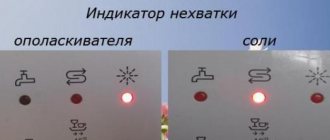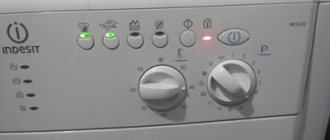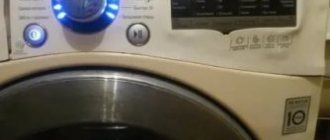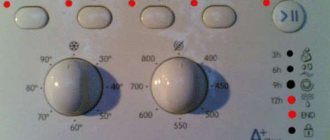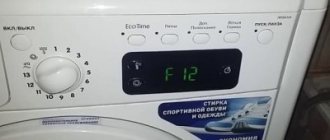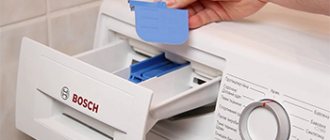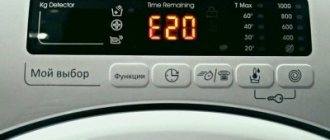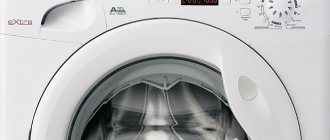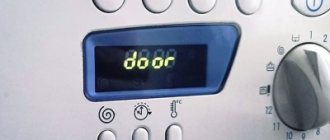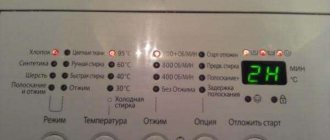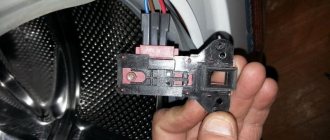- home
- Articles
- The red light on the washing machine is on
Different models of washing machines have different indicators that may light red. It could be a key, a lock, or just a red light. If it lights up during the washing or spinning process, this may indicate normal operation. But if, at the end of the washing machine’s program, the red light is on, and also if it blinks or lights up before selecting a program, this indicates a malfunction.
Button that starts processes
After successfully diagnosing the power cord and FPS, we move on to the dashboard. The fact is that on Atlant washing machines, when one or more keys stick, a failure occurs, after which the entire system is de-energized. While modern washing machines can withstand such a shock and display a corresponding error on the display, older models cannot cope with the load and simply “go silent.”
To understand whether the problem is caused by a stuck key, you need to perform several steps:
- open the detergent tray and, pulling it towards you, remove it from the housing;
- Unscrew all the screws holding the dashboard;
- carefully disconnect the panel from the machine (you don’t need to completely unhook the board - you just need to gain access to the “internals”);
- switch the multimeter to resistance mode;
- Apply the probes to the button contacts and measure the resistance.
Practice shows that sticking of the “Start” button more often leads to an emergency shutdown of the machine. If it works, then there is a problem with the other keys being used. We check everything sequentially. If sticking keys has nothing to do with it, then there is a high probability that the problem is in the electronic module. Here it is better to turn to specialists.
Share your opinion - leave a comment
Conclusions on the topic
If you are well versed in repairing household appliances and are planning to troubleshoot your dishwasher yourself, then you should try it. True, there is a sure way to avoid such troubles - compliance with operating rules.
The Ariston Hotpoint dishwasher is a faithful assistant that, with proper care and proper operation, will serve without problems or breakdowns for many years. However, if you still encounter a problem with the electronics or control module, it is better to immediately contact a qualified technician without wasting time on independent experiments with equipment repair.
Would you like to tell us how your dishwasher code system helped you identify the cause of a malfunction in a timely manner? Do you have information that is worth sharing with site visitors? Please write comments in the block below, post photos related to the topic of the article, and ask questions.
If the indicators light up, burn randomly or go out
The Indesit washing machine may start, but not work, not only because the lock does not turn on, but also due to other malfunctions, for example, a system failure. In this case, the lamps blink randomly or light up and immediately go out. You need to disconnect the machine from the network and wait a few minutes; if this does not help, open the instruction manual and look in it for information about performing a system reset.
In some cases, erratic blinking of light bulbs may occur due to wiring problems. It burns out or the connectors become loose due to constant vibration. It is necessary to carefully inspect the wires and then test them with a multimeter. Damaged elements are replaced with new ones. Usually you can talk about a wiring fault if the machine blinks and does not turn on.
If the lights blink in a certain sequence, this means that the machine has completed a self-diagnosis program and is reporting some kind of breakdown. To decipher the code, you need to open the user manual, it contains detailed information.
What Indesit error codes exist and what should I do?
The main errors issued by Indesit have values from F01 to F18, as well as H2O. However, there are exceptions to consider:
- F16 is typical exclusively for top-loading washing machines,
- F13-15 are not available on Indesit machines that do not have a drying function.
When a breakdown occurs, the code of which is displayed on the display or recognized by the number of blinks, the door is locked. Indesit error codes can signal both technical problems and incorrect inputs (exceeding the permissible load limit, for example). The Indesit washing machine can generate an error both at startup and during operation (when switching to rinsing or spinning, if a functional discrepancy is detected).
How to recognize a breakdown in equipment?
Complaints that the SMA does not turn on have a variety of manifestations that can accompany such a problem:
- when you press the “Start” button, the unit does not give any signals;
- after switching on, only one indicator blinks, and nothing else works;
- after an unsuccessful startup attempt, all light indicators light up and flash at once.
Sometimes the machine clicks and crackles, but the motor does not work, which means the drum does not rotate, water does not fill, and the SMA does not begin to erase. If you have made sure that current flows freely into the washing machine, then you need to take a number of measurements. They will allow you to identify the cause of failure of internal elements.
Failure to start washing is often due to a broken “On” button. A similar problem is common in the latest SMA models, in which current is supplied from the power cord directly to the button. In order to diagnose the serviceability of an element, you need to perform a number of simple steps:
- disconnect equipment from the power supply;
- raise the top panel of the unit;
- disconnect the control unit on which the button is located;
- disconnect the connection section of the wiring and buttons;
- connect a multimeter and calculate the supply of electric current in the on mode.
If the button is working properly, the device produces a corresponding sound.
If the equipment turns on and the light indicators on it light up, but the washing does not start, it is likely that the hatch is blocked. Most often, the SMA blocks the door at the start of the program
If this does not happen, then you should pay close attention to this node. To do this, you need to disassemble the front part of the SMA housing and then use a special tester to measure the voltage supply. If monitoring confirms that electrical current is flowing, but the device does not work, you will need to replace it
If monitoring confirms that electrical current is flowing, but the device does not work, you will need to replace it.
If the mechanism indicates a lack of voltage, then perhaps the problem is related to the failure of the command device or the working electronic unit.
Any unit has a special element responsible for suppressing electromagnetic radiation during operation - it is called an interference filter. This part protects the SMA from electrical waves that can render it inoperative. If the filter breaks, the machine will not be able to turn on - the indicators in this case do not light up.
Many SMAs are designed in such a way that the internal wires are in close contact, so if the equipment vibrates strongly, they can tear and fall out of the socket. In order to determine the area of damage, you should completely disassemble the MCA and use special testers.
Another common reason for no washing is a faulty electronic board. Its functionality is usually checked only after the accuracy of the connection of all operating microcircuits has been established, and the absence of damage to the wiring, plug, and also the mechanism responsible for locking the hatch door.
If the washing machine stops starting after a power surge, then the first thing you need to do is check the power supply filter - it prevents the electronic board from burning out and very often suffers itself if there is a fault in the electrical network.
This check is quite simple to carry out. To do this, you need to unscrew all the mounting bolts from the back panel and remove it, then find the surge protector (usually it is located on the side), and then carefully inspect all the wires and contacts leading to it. If you notice burnt out elements or a swollen filter, they will have to be replaced. If the problem cannot be detected, you need to test the contacts with a multimeter.
If the check does not produce any results and the network connection is working, then you should proceed to diagnostics of the command device. You will have to disassemble this element into the smallest parts and carefully inspect them. To do this you need to perform several steps:
- remove the command device and disassemble it;
- by pressing the latches located on the sides, you need to open the cover and remove the board;
- The board should be carefully inspected for burning, and then use a multimeter to measure the resistance at the contacts.
After this, all that remains is to make sure that there is no debris or foreign particles, visually determine the integrity of the working elements, if necessary, treat them with alcohol and reassemble them in the reverse order.
Hot water supply faults (error 2**)
These types of faults occur in Ariston double-circuit gas boilers. For hot water supply, the safety system is autonomous, which allows you to quickly identify the problem.
Many Ariston boiler models support the ability to connect a solar system as an alternative energy source for hot water supply. Therefore, some errors and warnings of the “2**” series are related to the operation of solar panels.
Error No. 201. Problem with the power supply to the temperature sensor - open or short circuit. It is necessary to eliminate the breakdown of the electrical wiring.
Errors No. 202-205 are related to the operation of the sensors. When the signal stops coming from them or it behaves unpredictably (sudden jumps in data), then these errors are triggered:
- No. 202. Problem with the boiler or solar system sensor.
- No. 203. Problem with NTC temperature sensor.
- No. 204-205. There is a problem with the temperature sensor that records the operating values of the solar collector.
To solve problems No. 202-205, you need to check the contact density. If this is not the case, then you will have to replace the faulty sensor.
Error No. 206. Problem with the cold water temperature sensor in the solar system. The solution is the same as for errors No. 204-205.
The temperature sensor is easier to replace than to clean. They are inexpensive, and they are easy to find, since parts with standard parameters are installed in the boilers
Error No. 207. Overheating of the solar thermostat. This may be caused by solar energy not being used to heat the water. Then the collector must be turned off. This malfunction can also occur when the thermostat breaks down. In this case, it will need to be replaced.
Error (warning) No. 208. Insufficient heating in the solar circuit. There is a risk of the coolant freezing. Turns on when the anti-freeze function is activated. Part of the energy from the gas will be used to heat the collector.
Error (warning) No. 209. Overheating of water in the boiler connected to the boiler. There may be a problem with the thermostat or its contacts.
How to fix the error yourself
Before proceeding with active steps, read the instructions supplied with the unit. It must contain a troubleshooting section that lists symptoms and/or error codes, as well as possible solutions. If the actions described in the instructions turned out to be useless or the instructions are completely lost, read our recommendations - perhaps they will help you understand how to fix the problem that has arisen in your washing machine.
There are several standard situations when the washing machine does not turn on, and several or all indicators on its body light up or flash alternately. Let's look at the most common of them.
| Cause of the problem | Remedies |
| There is no water flowing into the washing machine | Check:
|
| Control module failure | Try turning off the washing machine from the network and turn it on again after 10 - 20 minutes. |
| Child lock activated | Disable this option. Information on how to do this is indicated in the instructions for the washing machine. |
| The washing machine does not drain water | Make sure the drain hose is not clogged or kinked. If the washing machine drain is drained into the sink siphon, check for blockages and the connection between the drain hose and the sewer. |
| Damage to the power cord or plug | Check the integrity of the cable; if it turns out that the power cord is damaged, it should be replaced - this can be done independently or by contacting a specialist. |
| The washing machine is overloaded or underloaded | Arrange the laundry in the drum more evenly; if this does not help, you should reduce or, conversely, increase the machine load |
| Incorrect installation of the unit | You may have placed the drain hose below the level of the machine's tank, which is causing the washing machine to constantly fill and drain water, and then give an error message. Connect the machine to the sewer correctly or use the service of a washing machine installation specialist. |
If the buttons on the washing machine continue to blink and you cannot fix the problem yourself, most likely there is a breakdown. In this case, you cannot do without a professional washing machine repair technician.
Problems with water heating
If during the washing mode the washing machine freezes for a long time, stops, does not heat up, or constantly drains water, the causes of the breakdown should be sought in the heating circuit. The device will signal these problems with codes F04, F07 or F08.
Failure of the heating element or pressure switch and codes F04, F07
In washing modes where heating is required, the error may appear immediately after startup, or after drawing water, but rinsing or washing in cold water will work normally. In this case, there are several options for solving the problem (besides the standard turn on/off the machine to reboot the controller).
If the code appears on the display during the washing phase or during startup (the machine does not even want to draw water), most likely the reason lies in the heating element itself. It can “pierce” onto the housing when the contacts come off or simply burn out.
To fix the problem, you need to get to the heating element, check all its connections, change the resistance with a multimeter (with a power of 1800 W it should produce about 25 Ohms).
To replace a faulty heating element, disconnect the cable with wires, unscrew the fastening nut (1), press on the pin (2) and pry off the sealing rubber (3), then install a new part and reassemble in the reverse order
If the device collects and then immediately drains water, the cause may be a breakdown of the pressure switch - the water level sensor. If there is a problem, this element can provide the controller with information that the heating element was not immersed in water, which is why the machine does not start heating.
In this case, it is necessary to check the water pressure sensor tube with the pressure switch (the hose may become clogged, kinked, frayed, or come off). At the same time, inspect the contacts of the sensor itself - they may need to be cleaned. But more precisely, code F04 “speaks” about the failure of the pressure switch - most likely, the part will require replacement.
To check the operation of the pressure switch, you need to put a small piece of hose with a diameter identical to the removed tube onto its inlet fitting and blow - characteristic clicks will be heard from a working part
In some cases, the problem may be in the board itself, faulty wiring or contact groups in the area from the board to the heating element or water level sensor. Therefore, you should ring all the elements of the control unit associated with the operation of the heating circuit, and if necessary, replace the burnt tracks or the controller itself.
Heating circuit faults and F08 symbol
If the water heating does not work correctly (or the machine “seems” to start when the tank is empty), error code F08 will appear on the display. The cause most often is a malfunction in the pressure switch circuit.
This problem can occur due to high humidity in the room, which negatively affects the controller. To make sure the board is in order, inspect it, wipe it dry, or blow it with a hairdryer.
Another simple solution to the issue could be the disconnected contacts of the heating element and the pressure switch, especially if the device was started for the first time after transportation. In other cases, a more professional inspection will be required with possible replacement of parts.
First, make sure that there is really no water in the tank, then remove the back panel of the machine and check the heating element with a tester
Possible malfunctions of Ariston machines, indicated by code F8:
- If the washing mode is interrupted immediately after starting or during the washing phase and the device does not heat the water, the heating element will most likely need to be replaced.
- If the machine stops after starting, when switching to the rinsing mode, or does not spin, it is possible that the contact group of the heating element relay is “stuck” on the controller when it is on. In this case, you can replace the failed elements of the microcircuit and, if necessary, reflash the board.
- If the device “freezes” in various modes (and this can be either washing, rinsing or spinning), the wiring or contacts in the heater circuit may be damaged, or the pressure switch may break down, which considers that not enough water is entering the machine.
But if, when checking all the connections of the circuit and separately the pressure switch, the heating element relay and the heating element itself, no damage is detected, you will have to change the controller.
The washing machine blinks all the lights, but does not turn on
Lack of response to user commands, and the inclusion of all indicators and buttons indicates the presence of a technical malfunction - the control board is broken. This component fails due to power surges. Short circuits become a catalyst for capacitor burnout. If you know how to use a soldering iron, you can change them yourself.
Sometimes only the lock indicator lights up, but the machine still does not turn on. Make sure parental controls are deactivated. You may have turned on the child lock, so the buttons do not work. If only certain lights come on, for example, the service button indicator, then you need to disassemble the washing machine to check the serviceability of the following components:
— the electric heater (heater) burned out;
— there were problems with the pump;
— failure of the electronic motor;
— failure of the sensor transmitting commands.
It is necessary to identify the damaged node and restore its functionality. Modern washing machines are sensitive to overload because they are equipped with a special sensor that weighs the laundry before starting washing. To restart the cycle, open the door and arrange the clothes evenly or remove some of the laundry.
Error interpretation
What does it mean if the Ariston washing machine displays error F02 on the display? The reason may be a breakdown of the tachometer. There may be a short circuit or the contacts between the engine and the tachometer have burned out. Subsequently, the drum does not spin, and fault code F2 is displayed.
Ariston washing machine models differ in control methods. Therefore, error F 2 is issued differently in electronic and electromechanical systems.
A model from the Ariston Margherita series with 2 indicators: the “Network” LED flashes twice with an interval of 5-15 minutes. The “Key” - “Lock” LED lights up, the switch clicks and rotates clockwise.
Ariston AML type AML, AVL, AVSL: the “Quick Wash” LED flickers, the “Key” light flashes even more often.
Hotpoint-Ariston washing machine from the ARL, ARSL, ARXL, ARMXXL series: the “End of program” (END) indicator blinks, all program lights (bottom) are on.
Hotpoint-Ariston Aqualtis machines (AQSL): the temperature indicator flashes 30°.
Knowing what the error code means, you can begin troubleshooting.
Features of Indesit witl repair
For free
Call and diagnosis
Spare parts
Own warehouse
10% discount
For beneficiaries We continue the series of articles on repairing washing machines with our own hands. All Indesit witl 106, witl 86, witl 1067, witl 867 models are similar to each other and the repair problems are the same.
Washing machines can be assembled on an ARCADIA or EVO-II electronic board
This depends on your CMA product number.
Deciphering the error code by flashing indicators:
By adding the numbers corresponding to the blinking LEDs, you will receive an error code.
As an example of error F10, we add the sum 8+2=10 (F10).
Faults by error code (EVO-II board):
We have already published in a previous article how to troubleshoot a fault on the EVO-II board of WISL models by error code. They are similar to each other.
Faults by error code (ARCADIA board):
This board is the newest of all, it replaced the EVO-II. Installed since 2007. Schematic connection of the Arcadia control board with end devices
1. Anti-interference filter (power capacitor) 2. Heating element 3. Pump (pump) 4. Door locking device 5. Tachogenerator 6. Motor stator 7. Electric motor rotor 8. Main wash water intake solenoid valve 9. Pre-wash solenoid valve 10. NTC (temperature) sensor 13. Water level switch (pressostat) 14. Linear water level switch
When the machine does not display an error code:
— When plugged in, the door immediately locks (a click is heard) and the hatch lock indicator light comes on. Suspicion of a breakdown of the motor triac, burnout of the resistance, or short circuit of the motor.
It is necessary to remove the top cover by unscrewing the screws:
Visually inspect the board by unscrewing the fasteners:
Next, we use a tester to call the engine block (6 wires, 2 of which are red - tacho, and 4 black are divided in pairs: rotor and stator):
— Frequent malfunctions are associated with the engine. It is a collector type.
For example, after pressing the start button, the hatch lock is activated and “silence” occurs. In many cases, brush wear can be determined by external inspection or by the intensity of sparking on the engine commutator: both under load (there is laundry in the machine tank) and without it - in this case, abundant sparks occur (not along the entire perimeter of the commutator).
If the brushes wear out significantly, there is a loss of engine power - for example, if the drum of the washing machine does not “turn” with the laundry loaded into it.
Engine control circuit via tachogenerator (ARCADIA module):
— It takes an infinitely long time to wash, constantly filling and draining water.
It is necessary to properly organize the drainage system. The tip of the hose should be at a height of 60 to 100 cm.
In addition, a break in the stream must be ensured when draining to avoid water being sucked back into the SM.
-All indicators flash, except for the pre-rinse, main and rinse.
The hero of the occasion is the control unit (module), namely the switching power supply in it. An incorrect signal (voltage) is sent to the board and the lights blink.
Where is this module located:
With front loading, it is located under the tank on the rear side. In the vertical racks under the top control cover.
What to look for in the power supply is the swollen capacitors C17, C16, C20. We select new capacitors, maybe 1000 uF. We take a soldering iron and change
We select new capacitors, maybe 1000 uF. We take a soldering iron and change them.
Exploded top view:
001 - control knob 002 - white on/off/reset buttons 003 - white control panel 004 - bitron switch 005 - function keys 007 - display 008 - lid handle 010 - dispenser release lever 011 - dispenser hook spring 012 - dispenser release button 016 - cover support 018 - partition with shock absorber 021 - door locking device 022 - white dispenser 023 - siphon cover 026 - control panel wiring 027 - 8-pos. potentiometer
Ariston margarita 2000
The Margarita 2000 car has a stainless steel tank. The bearings are installed in a removable crosspiece mounted on the rear wall of the tank - it does not need to be removed to repair the bearing assembly. Repair sequence:
- Tighten the transport bolts.
- Remove the hatch on the rear wall of the device.
- Unscrew the fastening nut and remove the pulley using two screwdrivers.
- Remove the top cover and remove the counterweight.
- Place the machine on the front panel, having first removed the door.
- Unscrew the fasteners of the removable crosspiece of the tank.
- Using gentle blows, remove the cross from the shaft.
- Remove the oil seal and bearings from the crosspiece. Replace, lubricate and reinstall.
- Place the crosspiece on the shaft and carefully hit the bearings with a rubber mallet.
- Secure the crosspiece and pulley, put on the belt.
- Place the machine vertically and check the smooth rotation of the shaft.
- Install the front door, top cover and rear hatch.
Do-it-yourself repair of the Ariston Margarita 2000 washing machine is completed.
Major breakdowns
Let us repeat once again - in such a technically complex Indesit device there are things that can break and it is not always possible to cope with breakdowns on your own. But again, repairs do not always end in the workshop. Perhaps such strange behavior of the device as:
- the device began to work unstably;
- the detector lights on the control panel light up in a chaotic manner;
- if the display shows errors whose names begin with F;
- there are traces of leaks;
- there is a strong smell of burning wiring or smoke appears.
If this is noticed, then it’s time to pay serious attention to your home assistant and call a specialist for an examination. And the probable causes of breakdowns can be seen from the table
| Malfunction | Probable Cause | Eliminating the causes of breakdowns |
| the device does not turn on, there is no response to entered commands on the control panel, the indicators blink |
|
|
| the washing process begins to drag on in time, the modes themselves begin to respond to commands incorrectly or there is a need for manual control of the washing modes |
|
|
| loud noise and clatter from the washing machine |
|
|
| the drum stopped rotating |
| check the integrity of the power circuit to the drum lock electromagnet. |
| problems with filling and draining water |
|
|
| leaks |
|
|
| The washing machine does not spin or does not respond to commands at all |
|
|
| there was a smell of burnt wiring with the appearance of smoke |
|
|
Ten often causes problems with the washing machine
Troubleshooting
A Hotpoint-Ariston washing machine whose service life has not exceeded 5 years should work properly. If breakdowns are noticed during operation, you must first determine their causes. Thus, consumers most often notice problems with the drain pump, which quickly becomes clogged with various debris (threads, animal hair and hair). Much less often, the automatic machine makes noise, does not pump water, or does not wash at all.
Error codes
Most Ariston washing machines have a modern self-diagnosis function, thanks to which the system, after detecting a breakdown, sends a message to the display in the form of a specific code. Having deciphered such a code, you can easily find the cause of the malfunction yourself.
- F1. Indicates problems in the operation of the motor drives. They can be solved by replacing the controllers after checking all contacts.
- F2. Indicates that there is no signal being sent to the electronic controller of the machine. Repair in this case is carried out by replacing the engine. But before that, you should additionally check the fastenings of all parts between the motor and the controller.
- F3. Confirms a malfunction of the sensors that are responsible for temperature readings in the car. If the sensors are fine with electrical resistance, and such an error does not disappear from the display, then they will have to be replaced.
- F4. Indicates a problem in the functionality of the sensor responsible for controlling water volume. This often occurs due to poor connection between the controllers and the sensor.
- F05. Indicates a breakdown of the pump that drains the water. If such an error occurs, you must first check the pump for clogging and the presence of voltage in it.
- F06. It appears on the display when an error occurs in the operation of the machine buttons. In this case, the entire control panel should be completely replaced.
- F07. Indicates that the heating element of the machine is not immersed in water. First you need to check the connections of the heating element, controller and sensor, which is responsible for controlling the volume of water. As a rule, repairs require replacement of parts.
- F08. Confirms sticking of the heating element relay or possible problems with the functionality of the controllers. New mechanism elements are being installed.
- F09. Indicates system failures related to memory non-volatility. In this case, the firmware of the microcircuits is carried out.
- F10. Indicates that the controller responsible for the volume of water has stopped sending signals. The damaged part must be completely replaced.
- F11. Appears on the display when the drain pump stops giving operating signals.
- F12. Indicates that the connection between the display module and the sensor has been broken.
- F13. Occurs when there is a malfunction in the mode responsible for the drying process.
- F14. Indicates that drying is not possible after selecting the appropriate mode.
- F15. Appears when the dryer does not turn off.
- F16. Indicates that the car hatch is open. In this case, it is necessary to diagnose the hatch locks and the mains voltage.
- F18. Occurs in all Ariston models when the microprocessor malfunctions.
- F20. Most often it appears on the machine display after several minutes of operation in one of the washing modes. This indicates problems with water filling, which may be caused by failures in the control system, low pressure and lack of water supply to the tank.
Signal indication on a machine without display
Hotpoint-Ariston washing machines, which do not have a screen, signal malfunctions in various ways. As a rule, most of these cars are equipped only with indicators: a hatch closing signal and a power lamp. The door lock LED, which looks like a key or lock, lights up constantly. When you select the appropriate washing mode, the programmer rotates in a circle, making characteristic clicks. In some models of Ariston machines, each washing mode (“extra rinse”, “delayed start timer” and “express wash”) is confirmed by the lighting of a light bulb and the simultaneous flashing of the UBL LED.
There are also machines that have a blinking LED for closing the door “key”, a “spin” indication and a “end of program” lamp. In addition, Hotpoint-Ariston washing machines, which do not have a digital display, are able to notify the user of errors by flashing water heating temperature indicators of 30 and 50 degrees.
Rare reasons for all lights to blink
The visual information system sometimes works for other reasons. Sometimes confusion arises, so first you need to accurately determine the malfunction:
- involuntary drainage of water;
- burnout of the heating element for water and drying;
- motor failure;
- breakdown of the drain pump, etc.
If the washing machine is not working, the indicators will flash accordingly.
The heating element becomes coated with scale over time, causing increased wear. The motor can break down due to worn brushes or entangled hair and fur. The control device fails much less often; usually the cause is burnt contacts.
Check error codes according to Indesit instructions. Accurate diagnostics make it easy to repair the washing machine without major financial investments.
Developing code on machines without a screen
If the Ariston washing machine is equipped with a display, then there will be no problems with diagnostics - the washing machine will display the code and narrow the search field. With models without screens it is more difficult, since you will have to navigate by the display, in simple words, by the blinking LEDs on the dashboard. The frequency and number of flickers depend on the brand of the machine.
On Ariston Margherita type ALS109X, error F03 is manifested by the blinking of two keys on the panel - power and UBL. The lights glow in a triple series, after which they go out for 5-10 seconds and light up again. At the same time, the programmer “signals”: it clicks and rotates clockwise.
Machines of the AVL, AVTL, AVSL and CDE series report impossible heating by indicating the two lower keys responsible for additional options. Their names vary depending on the brand; as a rule, “Extra rinse” and “Quick wash” blink; less often, “Reduced spin speed” and “Easy ironing” blink simultaneously. The “Key” button also lights up actively, and with greater frequency.
The Low-End model range of Hotpoint-Ariston (for example, ARSL, ARXL and AVM) issues F03 through the two lower LEDs “Hatch Lock” (on some models referred to as “Key”) and “End of Cycle” (sometimes the option “END” is found "). Additionally, the additional function keys located:
- horizontally (on brands of the Ariston BHWD, BH WM and ARUSL line);
- vertically (ARTF, AVC and ECOTF washing machines).
Owners of Hotpoint-Ariston machines from the Aqualtis model range can detect error F03 through the blinking of lights indicating the temperature selection. We are talking about “No heating” and “30°”.
Preparing for fault diagnosis
If such a situation occurs with an Indesit machine, the first thing we do is disconnect it from the network, and do not open the hatch. First, use the button on the panel, then disconnect the cord from the outlet. Cover the floor around with towels and rags, place a container underneath the drain filter, like a scoop or container, and only then open it. The plug opens counterclockwise; if it is screwed tightly, use pliers. After all the water has drained, you can clean the drum from the laundry.
After all the operations, it is worth understanding at what point the drum stopped rotating. The chronology of work will help to establish the exact reason for its stop. If a failure occurs during the spin cycle, and the laundry is damp but not soapy, then you need to check the selected washing mode. If the delicate wash is turned on or the “no spin” function is active, then this small misunderstanding can be easily corrected. The water does not drain due to a blockage in the drain system, and therefore spinning does not occur. Also, stopping the drum’s operation may be due to an overload of things, due to which an imbalance has occurred. Problems with the pressure switch or control module lead to failures during the washing process. Expressed in burnt out wiring or errors in the control module.
Signs of breakdown and repair
Before you begin to solve the problem, it is worth accurately diagnosing the problem that has arisen. If among the signs of a breakdown is a door that does not close, a lock that disappears in the middle of a cycle, or a hatch that does not open at the end of the program, then UBL is 75% to blame. As already noted, it is responsible for achieving a seal in the drum and a locked door. The device cannot be repaired - only a full replacement.
Another possible failure is a faulty control module. The control board coordinates the operation of the machine, reads and transmits commands from one element to another. When the electronic controller begins to slow down, the relationship is disrupted and the system generates an error. The cause will be burnout of resistors, LEDs, triacs or varistors.
Other problems are often to blame for the display of “F17” or “door”:
- oxidized or burnt contacts on radio elements;
- failures in the control board firmware;
- faulty electronic controller processor.
Among the reasons may be worn out electric brushes on the commutator motor. On many Hotpoint Ariston models, the board controls the operation of the UBL through monitoring the circuit, which includes the engine. If damage is detected on the engine, for example, wear of the carbon brushes, the system often interprets it as problems with the hatch blocking. It is logical that repair will have to be replaced.
If it is impossible to close the hatch tightly due to the door tongue not fitting into the housing opening or the absence of a click, we act differently
First of all, we pay attention to two points
- Door hinges. The door is probably warped and cannot fit into the factory grooves. The reason for loose clamps is due to mechanical stress, for example, when children ride on an open hatch. To continue washing you will need to replace one or two holders.
- Locking mechanism. Both natural sagging and mechanical shock can break the tongue. As a result, the tongue does not fit into the groove. Disassembling the hatch and replacing damaged parts will help solve the problem.
The last reason leading to “F17” or “door” is damage to the wiring in the area from the module to the UBL. Telling signs will be a failure to activate the lock, its disappearance during the washing process, or an error display during the spin or drain cycle. Such troubles can be caused by abrasion of the conductor on the sharp edge of the drum or damage to the insulation by rodents. It is safer and more reliable to turn to professional repairmen. If you decide to act alone, then we avoid twists and loose connections.
Do-it-yourself repairs
Modern Indesit devices have a display to monitor the operating status. If any malfunction occurs, an error code is displayed on the display. In the instructions supplied with the washing machine, you can find a decoding of the codes. Having determined the cause of the breakdown, it is easier to fix the problem on your own or invite a specialist from the workshop and calculate the amount of repair work.
LCD display of washing machine
But there are also devices that do not have an LCD display and an error removal program. The owner of the washing machine will then have to proceed with the inspection and try to fix the problem himself. If the control panel does not light up with all the colors of the signal lights, there is no smoke or burning smell, and there are no leaks, this means that there are no serious breakdowns and you can try to fix the problem on your own.
Here are some simple problems and ways to solve them:
- When you press the power button, nothing happens - check whether the plug is inserted or whether the contact is tight enough. It is also possible that the mechanism for protecting the electrical network from a short circuit has tripped. This can happen from strong power surges;
- water does not flow - restart the machine by pressing the start and stop button. Check that the door is closed tightly and that there is enough water pressure. Is the water supply tap turned off?
- if nothing happens after pressing the start button, repeat the same steps. Check whether the water supply hose is damaged or whether the delayed washing mode is running;
- Check the installation height of the drain hose if there is constant draining and intake of water. Bring the high point of the hose to a height of 70 centimeters;
- extraneous loud sounds can be caused by solid objects that have fallen out of pockets getting into the washing machine drum - coins, pens, and so on;
- Excessive foaming makes work difficult and is caused by incorrect selection of washing powder. Washing powder must be specifically for automatic machines;
Excessive foaming is also a cause for concern
- the “spin” function does not work or the water does not come out after the “rinse” cycle - the drain hose may be kinked or clogged. The mode may be incorrectly selected. With the “light ironing” or “no spin” modes, this effect may occur. Restart the washing process by pressing the "Start/Pause" button. To find out other reasons why, we recommend studying this material;
- If there is strong vibration or during washing, or during the spinning process of the Indesit machine, check the uniform distribution of the laundry. If the device has been moved to another location, check whether there is any distortion in the installation;
- All the indicators came on at once for no apparent reason. A complete disconnection from the power supply will help. When turned on again, their operation may be restored.
Washing machine disassembly diagram
If there is no power
There are a number of reasons why the equipment does not work after switching on. If the display or indicators on the Indesit washing machine do not light up, this indicates a lack of power. This happens if:
- There is no electricity.
- The machine or RCD tripped.
- The socket is faulty.
- The power cord is broken.
- The power button is broken.
- FPS malfunction.
- The control unit is broken.
Electricity problems
The first thing you should check if the automatic washing machine shows no signs of life is the presence of voltage. You can turn on the lights and other mains-powered devices to make sure there is electricity.
If there is a separate line to the Indesit washing machine, you should make sure that the machine is not knocked out. This could happen if moisture got into the outlet or there was a short circuit. You need to check it and turn it on if it is knocked out. If it turns off again, you need to look for the cause of the short circuit.
If the equipment is connected through an RCD, it could be triggered if electricity leaks to the body. Sometimes the protective confinement device fails if it is of poor quality or the wiring is poorly done.
Another reason why the Indesit washing machine does not receive power is a malfunction of the socket or extension cord through which the product is connected to the network. You can connect another electrical device to them or use an indicator screwdriver, a multimeter or a light bulb with wires attached.
If everything is in order with the electricity, you should proceed to diagnosing the Indesit washing machine. To do this, you will need to disconnect it from the network.
The power cord is faulty
First you need to inspect the power wire. It may have been broken due to constant bending or damaged by pets. If no external defects are found, you need to “ring” it with a multimeter. If the wire is truly faulty, it should be replaced or, if a break is detected, twisted. But it is not recommended to resort to the last method.
Power button broken
After the power cord, you need to check the power button. This can be done with a multimeter operating in buzzer mode. After this, you need to ring the button. If it is turned on and working properly, the multimeter will beep, but if it is in the off position, the device is silent.
FPS is faulty
The next part that needs to be checked after the power button is the noise filter (FPS). Its purpose is to eliminate electromagnetic waves coming from the Indesit washing machine that interfere with the stable operation of a TV, radio or other equipment located nearby. If it is damaged, the current no longer flows and the washing machine does not turn on. The filter also protects the control unit from burnout after a power surge. To troubleshoot the problem you must:
- Disconnect the machine from the sewer and water supply.
- Unscrew the fasteners and remove the back cover.
- The mains capacitor is located near the left side wall; you need to remove it and disconnect its wire from the mount. If the filter is burnt out, it can be easily determined visually.
- Now you need to disconnect the contacts of the power cord, disconnect the FPS, set the multimeter to ring and check the wire. If it is defective, it must be replaced.
- Next you need to call the FPS. If it rings, you need to check the capacitor with a multimeter in resistance test mode. If it is faulty, the display will show a zero or a one. In this case, the part needs to be replaced. You need to purchase a new one in accordance with the device model; it is sold both separately and with a power cord.
Varistor is faulty
The next thing you need to check is the varistor. This is the name of a semiconductor resistor that is soldered into the system board and protects it from surges. During power surges, they often burn out, after which the Indesit washing machine does not turn on and the indicators do not light up. To check it, you need:
- Pull out the detergent cuvette, there are two screws under it, they need to be unscrewed.
- Remove the top cover, unscrew the fasteners, and remove the control panel.
- Disconnect the central board.
- Find varistors. If they are burned, as a rule, they are easy to detect - they are blackened or burnt with traces. If external damage is not visible, you need to check it with a multimeter in resistance mode.
- The non-working varistor needs to be unsoldered, then purchased a similar one from a service center or store and soldered in its original place.
If, after checking and replacing the varistor, the washing machine still does not turn on, you should contact a specialist for further repair work. It is not recommended to try to repair the control board yourself, because you can completely damage it.
Interference filter (FPS): meaning and performance check
The control module, electric motor and other parts create radio frequency waves when the washing machine is running, which can harm other household appliances located near the machine. To protect electrical devices, the machine is equipped with an interference filter. If it malfunctions, it will create an obstacle to the passage of electric current. This will be the reason why the automatic machine does not start the washing process. To check the functionality of this part, you need to diagnose the wires at the input and output, as well as the device itself using a tester. If the FPS does not work, you need to order a new filter from the service center or make a request for its replacement.
If the sunroof lock light is blinking
One of the common problems is the door lock lamp blinking. At this time, the machine may not start, work or stop in the middle of the cycle, the door cannot be opened.
This problem can happen for several reasons:
- the tamper protection function is activated (parents often turn on the Child Lock mode to protect the device from curious kids who may accidentally mess up the program settings);
- no water flows into the machine;
- the hatch door is not completely closed;
- failure in the control program (this problem usually occurs due to power outages or power surges);
- the door lock does not work;
- The heating element is faulty (with this breakdown, the machine continues to operate, only washing takes place in cold water).
Troubleshooting and troubleshooting
If you are well versed in technology, then you can figure out all the problems yourself. You can check the condition of the electronic board and fix breakdowns at home, but first you will have to disassemble the unit.
To do this you need to do the following:
- de-energize equipment;
- remove the housing cover;
- unscrew the hex screws holding the control board;
- disconnect all wires from the connectors;
- change the capacitors (or the board itself).
In front-loading Indesit models, the electronic board is located at the bottom of the rear. Getting to it won’t be difficult if you have the most common tools. For diagnostics, it is better to use a multimeter, which can be used to “ring” capacitors and contacts.
Unwinding the case usually does not cause problems, but each model has its own design features. The control panel is mounted with two bolts at the back, and the electronic board is held in place with small screws.
Top-loading models have the electronic control panel at the top, while front-loading models have it at the lower rear.
When externally examining the electronic board, look for capacitors that have a round shape. Particular attention is paid to capacitors C16, C17 (capacitance from 680 mF to 1000 mF), C20. If they fail, they usually start to swell at the top. To accurately diagnose a breakdown, you can “ring” them with a multimeter. When replacing capacitors, you must carefully check the markings to select the exact model for your washing machine.
If there is no power
There are a number of reasons why the equipment does not work after switching on. If the display or indicators on the Indesit washing machine do not light up, this indicates a lack of power. This happens if:
- There is no electricity.
- The machine or RCD tripped.
- The socket is faulty.
- The power cord is broken.
- The power button is broken.
- FPS malfunction.
- The control unit is broken.
Electricity problems
The first thing you should check if the automatic washing machine shows no signs of life is the presence of voltage. You can turn on the lights and other mains-powered devices to make sure there is electricity.
If there is a separate line to the Indesit washing machine, you should make sure that the machine is not knocked out. This could happen if moisture got into the outlet or there was a short circuit. You need to check it and turn it on if it is knocked out. If it turns off again, you need to look for the cause of the short circuit.
If the equipment is connected through an RCD, it could be triggered if electricity leaks to the body. Sometimes the protective confinement device fails if it is of poor quality or the wiring is poorly done.
Another reason why the Indesit washing machine does not receive power is a malfunction of the socket or extension cord through which the product is connected to the network. You can connect another electrical device to them or use an indicator screwdriver, a multimeter or a light bulb with wires attached.
If everything is in order with the electricity, you should proceed to diagnosing the Indesit washing machine. To do this, you will need to disconnect it from the network.
The power cord is faulty
First you need to inspect the power wire. It may have been broken due to constant bending or damaged by pets. If no external defects are found, you need to “ring” it with a multimeter. If the wire is truly faulty, it should be replaced or, if a break is detected, twisted. But it is not recommended to resort to the last method.
Power button broken
After the power cord, you need to check the power button. This can be done with a multimeter operating in buzzer mode. After this, you need to ring the button. If it is turned on and working properly, the multimeter will beep, but if it is in the off position, the device is silent.
FPS is faulty
The next part that needs to be checked after the power button is the noise filter (FPS). Its purpose is to eliminate electromagnetic waves coming from the Indesit washing machine that interfere with the stable operation of a TV, radio or other equipment located nearby. If it is damaged, the current no longer flows and the washing machine does not turn on. The filter also protects the control unit from burnout after a power surge. To troubleshoot the problem you must:
- Disconnect the machine from the sewer and water supply.
- Unscrew the fasteners and remove the back cover.
- The mains capacitor is located near the left side wall; you need to remove it and disconnect its wire from the mount. If the filter is burnt out, it can be easily determined visually.
- Now you need to disconnect the contacts of the power cord, disconnect the FPS, set the multimeter to ring and check the wire. If it is defective, it must be replaced.
- Next you need to call the FPS. If it rings, you need to check the capacitor with a multimeter in resistance test mode. If it is faulty, the display will show a zero or a one. In this case, the part needs to be replaced. You need to purchase a new one in accordance with the device model; it is sold both separately and with a power cord.
Varistor is faulty
The next thing you need to check is the varistor. This is the name of a semiconductor resistor that is soldered into the system board and protects it from surges. During power surges, they often burn out, after which the Indesit washing machine does not turn on and the indicators do not light up. To check it, you need:
- Pull out the detergent cuvette, there are two screws under it, they need to be unscrewed.
- Remove the top cover, unscrew the fasteners, and remove the control panel.
- Disconnect the central board.
- Find varistors. If they are burned, as a rule, they are easy to detect - they are blackened or burnt with traces. If external damage is not visible, you need to check it with a multimeter in resistance mode.
- The non-working varistor needs to be unsoldered, then purchased a similar one from a service center or store and soldered in its original place.
If, after checking and replacing the varistor, the washing machine still does not turn on, you should contact a specialist for further repair work. It is not recommended to try to repair the control board yourself, because you can completely damage it.
How to open the door if the handle is broken?
If the door cannot be opened after the cycle, do not pull or yank it.
Such behavior will lead to damage to both the handle and the locking lock. If a breakdown has already occurred, you can open the door using a rope or cord.
Process progress:
- To open the door, a rope with a width not exceeding 5 mm is suitable. And its length should be 25 cm greater than the diameter of the hatch.
- Insert a rope into the space between the device body and the door. If it is difficult to do this manually, then it is better to take a flat screwdriver or spatula. However, the tools must be used with great care.
- The rope must be pulled to the left until a click is heard.
Instead of rope, you can use a bank card. It must be inserted under the hatch, in the area where the lock-lock is located. The card will press the tongue of the mechanism and the door will be unlocked.
